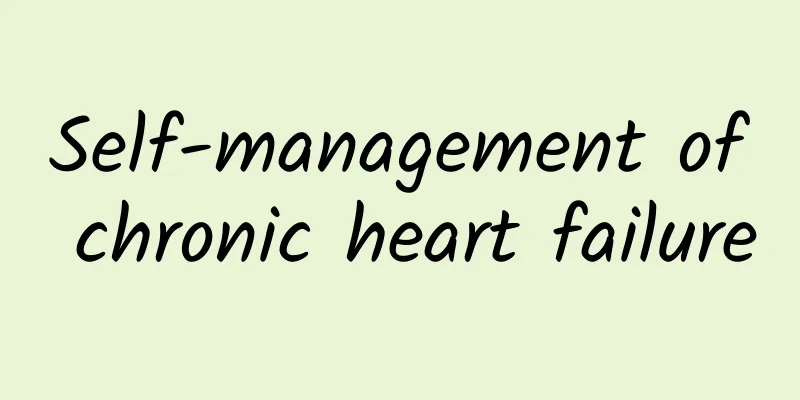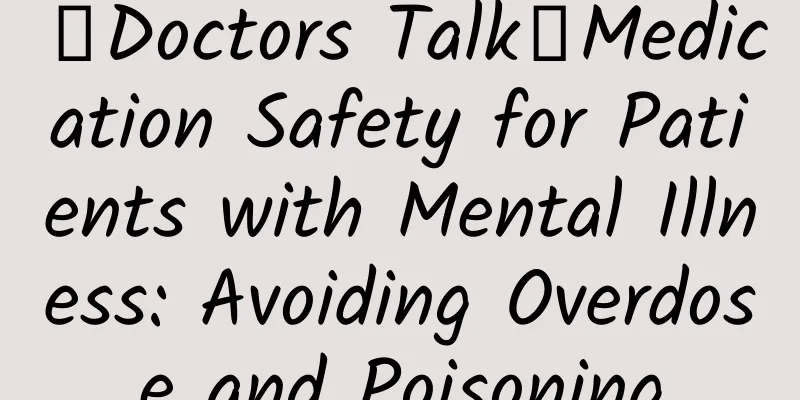Self-management of chronic heart failure

|
Author: Zheng Zhichang, deputy chief physician of China Rehabilitation Research Center Reviewer: Wang Lei, Chief Physician, Beijing Friendship Hospital Figure 1 Copyright image, no permission to reprint Heart failure (abbreviated as "HF") is the late or terminal outcome of various heart diseases, and is also the most difficult disease to conquer in the cardiovascular field. Epidemiological survey data show that the prevalence and mortality of heart failure in my country are increasing year by year. There are currently about 12.1 million heart failure patients over the age of 25, and about 3 million new heart failure patients each year. The mortality and re-hospitalization rates of heart failure patients are very high. More than 1 million heart failure patients are hospitalized in my country each year, and the re-hospitalization rate due to heart failure within 6 months after discharge is 25% to 40%. Heart failure patients have poor quality of life and high medical expenses, which has placed a huge economic burden on society and families. In fact, heart failure is a disease that can be prevented, treated and controlled. Early detection, accurate diagnosis, reasonable intervention and long-term management can effectively delay the progression of heart failure, improve the quality of life of heart failure patients, and reduce the hospitalization rate and mortality rate of heart failure patients. In the process of controlling chronic heart failure, drugs can play half of the role, and the other half is the patient's self-management. After being discharged from the hospital, heart failure patients can stabilize their condition and prolong their lifespan through self-management at home. It can be said that if you manage well, you can live well! So, what aspects does daily home management of patients with chronic heart failure include? There are four main aspects: diet, exercise, medication and daily monitoring. 1. Diet In terms of food types, there is no food that heart failure patients cannot eat. They just need to focus on dietary balance and maintain a reasonable proportion of vegetables, fruits, meat, eggs, rice and noodles. The key thing to remind everyone here is to limit water and salt as required. Figure 2 Copyright image is not authorized for reproduction (1) Water restriction It is generally recommended that the daily fluid intake is less than 2L. The fluid here is not just the water that is drunk directly, but also includes the water obtained from food and liquid medicines. Once patients with chronic heart failure drink too much water or infuse too much fluid while the urine output is small, it is very likely to cause a heart failure attack. The water intake restrictions for patients with severe heart failure are more stringent, and the daily water intake should not exceed 1.5L. When discharged from the hospital, doctors generally instruct patients on the daily water intake based on the current heart condition. Patients need to follow the doctor's advice and arrange water drinking reasonably according to the morning, noon and evening time. During the home rehabilitation process, heart failure patients can prepare a cup with a scale to facilitate the allocation of daily water intake. When drinking water, you can prepare a small cup of about 30 ml and drink it in small amounts at several times. You can also add a few slices of lemon to the water. The appropriate sour taste can activate saliva secretion and relieve thirst. If there are liquid or semi-liquid foods in the diet, such as porridge, soup, paste and other foods with high water content, or a lot of fruits, the water content of these foods must also be calculated to arrange the daily liquid intake reasonably. (2) Limit salt intake At present, the average daily salt intake of Chinese residents is 7 to 20 grams, which is higher than the daily salt intake recommended by the "Dietary Guidelines for Chinese Residents" (less than 6 grams). For patients with mild or stable heart failure, it is generally not recommended to strictly limit sodium salt intake. Generally, 4 to 6 grams of regular salt per day is enough. It is recommended to use a salt spoon for daily cooking. A salt spoon that can hold 2 to 3 grams of salt is enough; if there is no salt spoon, you can use an ordinary beer bottle cap to fill the cap with salt, which is equivalent to 5 to 6 grams. In addition, patients with heart failure should avoid eating high-salt pickled foods, such as pickles, bacon, and pickled vegetables; use less high-salt sauces and soy sauce; also be wary of hidden salt, such as chicken essence, MSG, and various processed foods; drink less high-salt beverages, such as some sports drinks rich in electrolytes. 2. Exercise gradually Patients with chronic heart failure, especially moderate to severe heart failure, should pay attention to rest. For example, patients who have shortness of breath after slight activity should rest in bed more often and can perform passive lower limb exercises with the help of family members to avoid muscle atrophy and venous thrombosis. When the symptoms of heart failure stabilize, you should gradually increase your activity level so as not to cause symptoms or feel tired. After the condition improves further, you can insist on a certain intensity of exercise based on your own tolerance, but be sure to do it within your ability. Patients with heart failure should correctly understand their physical condition, not blindly compare themselves with healthy peers, always take care of themselves, do appropriate physical activities, not overwork, and avoid stress states such as emotional excitement and mental tension. They can follow up regularly with the cardiology department, where a cardiologist will assess their activity ability. 3. Standardized use of drugs Long-term standardized drug therapy is the cornerstone of treating chronic heart failure. To achieve standardized treatment, compliance and follow-up are very important. Compliance means taking medication according to doctor's orders. Do not stop or reduce medication without permission to avoid recurrence or aggravation of the disease. Do not add anti-inflammatory analgesics, hormones, etc. without the consent of a specialist. Home medication management should be combined with regular follow-up. Patients with heart failure generally have multiple comorbidities or fluctuations in blood pressure or heart rate. Therefore, it is necessary to pay attention to possible adverse reactions when multiple drugs are used in combination and adjust the treatment plan in a timely manner. In general, patients whose drugs have reached the target or maximum tolerated dose and whose condition is stable can be followed up once every 1 to 3 months. 4. Monitor weight, blood pressure, heart rate, etc. Figure 3 Copyright image is not authorized for reproduction (1) Use a bathroom scale to monitor weight changes. Using a scale to monitor weight is recognized as one of the simplest, cheapest, but most effective ways to manage heart failure. In clinical practice, many patients are often hospitalized due to severe edema. However, edema can actually be detected in the early stages of its onset. An effective method is to use a scale to monitor weight every day. Changes in weight can help detect fluid retention early and intervene in advance. For example, if the weight suddenly increases by more than 2 kg within 3 days, hidden edema should be considered, and a doctor should be consulted in time to adjust medication. (2) Use a sphygmomanometer to monitor blood pressure and heart rate. Monitoring blood pressure and heart rate every day can help you understand changes in your condition in a timely manner. Heart failure patients should measure their blood pressure and heart rate at least once a day and keep records. In addition to letting doctors understand your condition, doctors can also adjust medication based on your blood pressure and heart rate. (3) Symptom monitoring. In addition to monitoring weight, blood pressure, and heart rate, heart failure patients also need to pay attention to their own physical feelings. Chronic heart failure patients often have some small hints in their bodies that indicate the onset of heart failure. Patients may feel tired and weak, which may affect their daily activities and work life. If there is no special reason for fatigue and weakness in the recent period, they should be alert to heart failure; if they feel chest tightness and shortness of breath after slight activities and need to stop and rest many times to relieve the pain, it may be a sign of heart failure; if they cough after activity or have night coughs, it may also be a manifestation of heart failure; if patients have lower limb edema, especially edema in the ankles, and a dent is formed when pressing with fingers, it is usually a manifestation of heart failure; some patients with heart failure can usually lie down to sleep at night. If they experience chest tightness and shortness of breath when lying down to sleep, and the pain is relieved after sitting up, it is also a sign of heart failure. In terms of the prevention and monitoring of heart failure, patient self-management and outpatient follow-up are very important. Patients can join some heart failure management programs under the recommendation of cardiologists to reduce the patient's hospitalization and mortality rate. The improvement of patients' self-management ability and treatment compliance can greatly improve the patient's health status and reduce the risk of re-hospitalization due to worsening heart failure. Patient self-management is of great significance. I hope that every patient with chronic heart failure can have a relatively good quality of life through good self-management! |
<<: They are really brothers in distress. What should we do if we meet them?
>>: Overeating is a heart disease
Recommend
Will taking Fuyanxiao capsules cause yellow urine?
Fuyanxiao Capsule is a capsule made from a tradit...
What is the difference between the anti-allergic drugs cetirizine and levocetirizine, as there is an extra "left" in their names?
Cetirizine is a commonly used drug for the treatm...
The third day after menstruation is the safe period
Women have the ability to get pregnant since they...
What are the precautions after artificial insemination?
Artificial insemination is a relatively common me...
Quick Q&A - Shingles (17 useful questions).
1. What is shingles? Herpes zoster is a disease c...
Delayed implantation of fertilized egg
The sperm and egg combine to form a fertilized eg...
What is the lantern fruit? What is the nutritional value of the lantern fruit?
In the summer fields, you can often see small gre...
Can I eat bacon during my period?
In many countries, bacon is the first choice for ...
37 weeks pregnant anal swelling
It usually takes ten months, or about forty weeks...
What does vaginal blowing mean?
Women who have had frequent miscarriages or have ...
What should I pay attention to when I have ovarian cysts?
What should you pay attention to if you have ovar...
What should women eat to nourish their kidneys? 10 foods to help you!
In everyone's impression, kidney tonification...
What is the cause of severe hair loss? Treatment for hair loss
Severe hair loss is largely due to the lack of ir...
How many months do stretch marks begin to appear?
Under normal circumstances, the collagen fibers i...
How to comfort a crying girl
Because girls are more emotional animals than boy...









